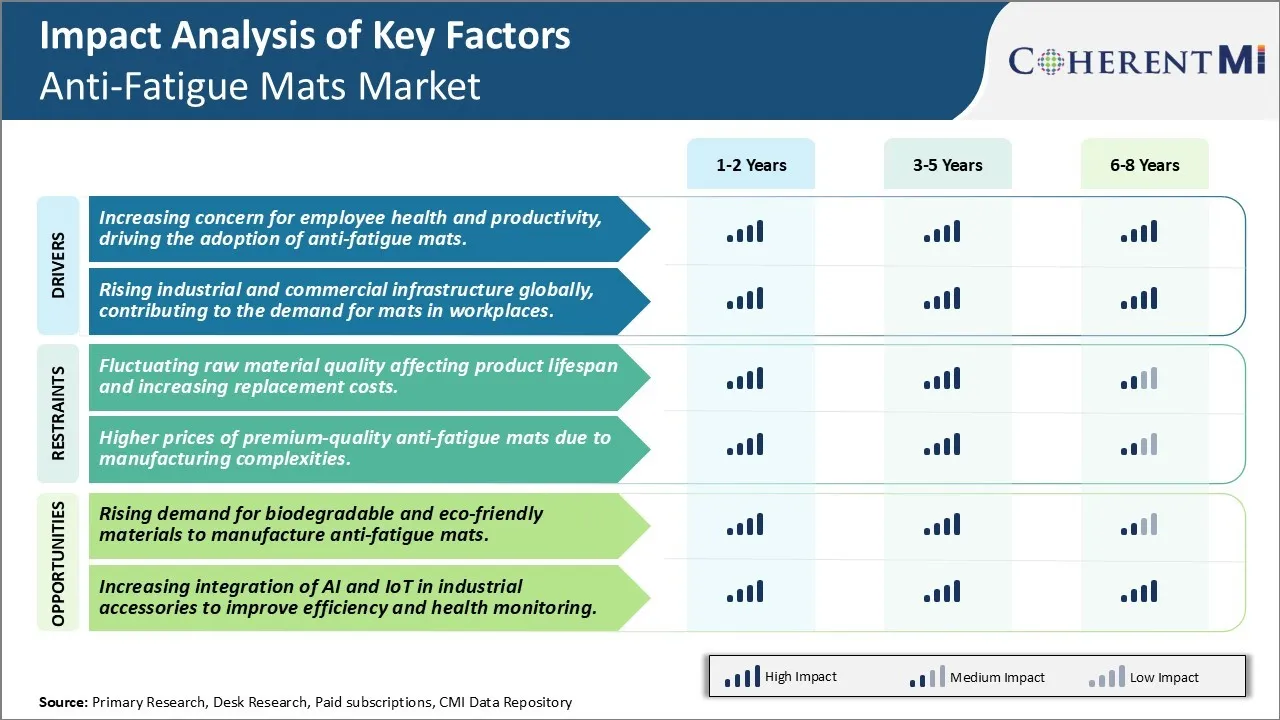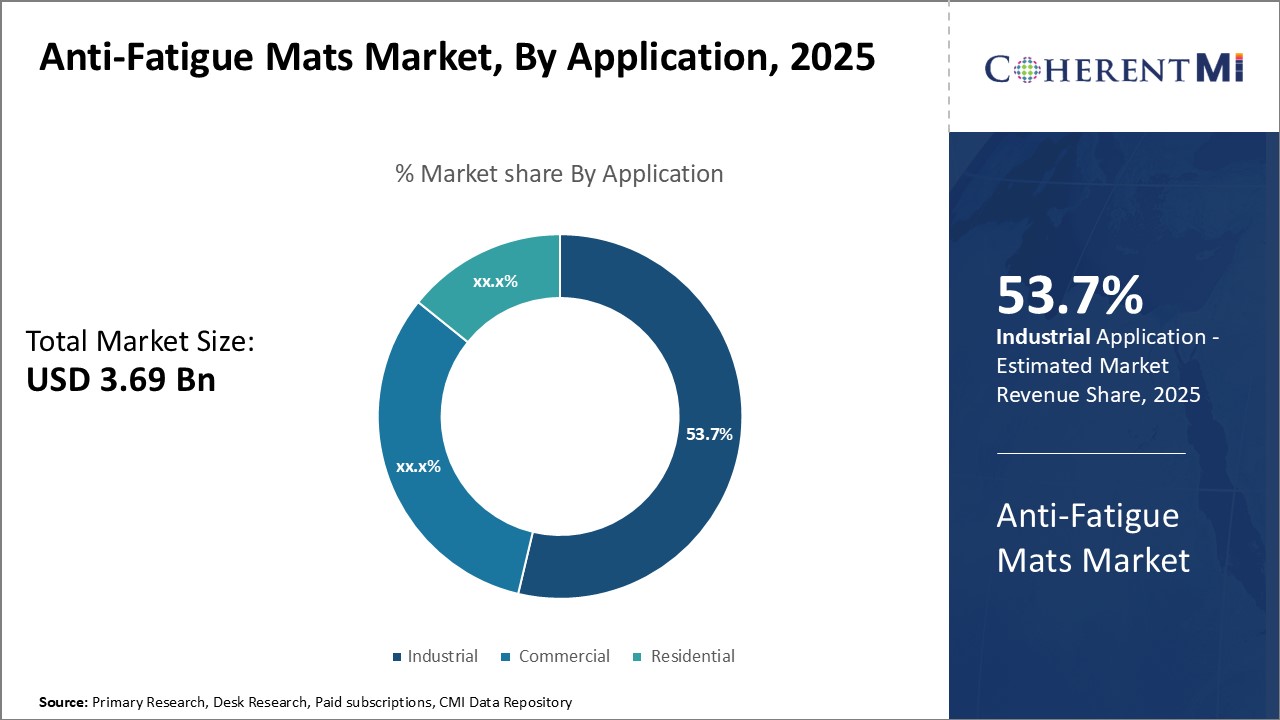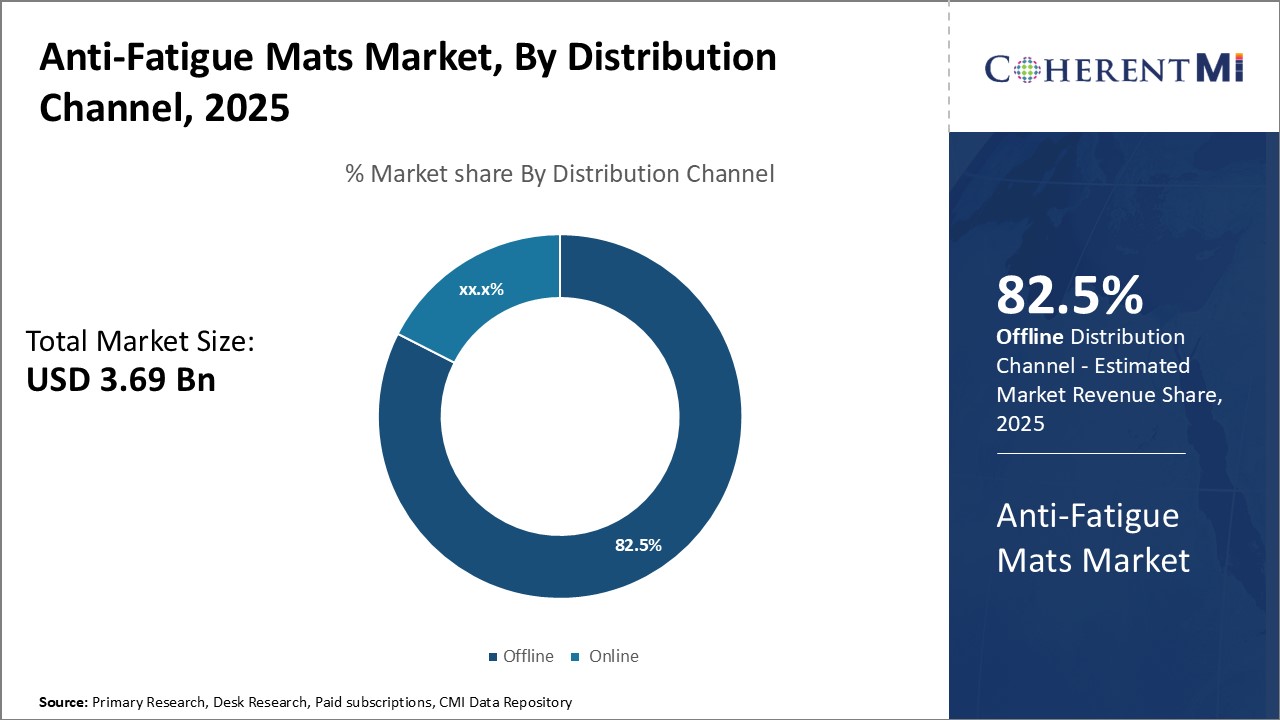Anti-Fatigue Mats Market Size - Analysis
Anti-fatigue mats are specially designed floor mats that reduce fatigue caused by standing for long periods on hard surfaces. Typically made from materials like rubber, foam, or gel, they provide cushioning and promote subtle movements, improving blood circulation and reducing strain on the legs, feet, and lower back. These mats are commonly used in workplaces like factories, kitchens, and retail settings where prolonged standing is required. By providing ergonomic support, anti-fatigue mats can enhance comfort, reduce the risk of musculoskeletal disorders, and improve worker productivity and overall well-being in standing work environments. The anti-fatigue mats market is driven by the rapid growth of the industrial sector and increasing focus on workplace ergonomics and safety. Various advancements including the development of activity-sensitive, tech-integrated and eco-friendly mats are expanding the scope of industrial anti-fatigue mats. New technologies are making mats smarter by tracking metrics like steps and calories burned.
Market Size in USD Bn
CAGR5.5%
| Study Period | 2025-2032 |
| Base Year of Estimation | 2024 |
| CAGR | 5.5% |
| Market Concentration | High |
| Major Players | NoTrax, 3M Corporation, Wearwell, LLC, Smart Step Flooring, Durable Corporation and Among Others |
please let us know !
Anti-Fatigue Mats Market Trends
Many organizations are realizing the importance of employee health, safety and well-being in the workplace. Prolonged periods of standing without any support can cause strains and fatigue to the feet, leg muscles and back. This affects the productivity of workers and increases absenteeism due to health issues. As per studies, proper ergonomics at the workplace can help reduce costs associated with injuries, workers compensation and lost productivity.
With growing health concerns and work stress in today's fast-paced environment, companies realize the need to prioritize workers comfort and safety. Government regulations in some countries also mandate facilities to ensure ergonomic compliance at workplaces. Proactive employers conducted internal analyses which highlighted significant cost benefits realized through lower healthcare and compensation costs versus the affordable investment needed for anti-fatigue floor mats. Rising health insurance premiums provide further impetus to implement solutions for preventing work-related illnesses or injuries. The economic and social advantages of a healthier workforce have prompted varied industries to adopt anti-fatigue mats.
Market Driver - Rising Industrial and Commercial Infrastructure Globally, Contributing to the Demand for Mats in Workplaces
The increase in factory and facility sizes inherently leads to a rise in the number of employees who spend long duty hours on their feet. Further, greenfield projects and brownfield facility extensions involve prolonged physical work for construction workers too. With growing awareness of occupational health hazards, such projects are integrating ergonomic considerations from the start. This stimulates incorporation of anti-fatigue flooring like interlocking foam mats or rubber grid mats throughout the work areas and assembly lines.

Market Challenge - Fluctuating Raw Material Quality Affecting Product Lifespan and Increasing Replacement Costs.
With growing awareness about environmental sustainability, there is increasing consumer preference for green products across sectors. The anti-fatigue mat market is no exception to this global trend. Users and corporate buyers are more willing to invest in mat options that are manufactured using natural and recyclable materials. This opens up a major opportunity for mat companies to develop new product lines with fillers and backing surfaces derived from renewable bio-based sources like cork, bamboo, coconut coir and recycled rubber. Such eco-friendly components enhance a mat's green credibility without compromising quality or performance. Forward-thinking manufacturers are leveraging this demand shift by incorporating biodegradable materials in their mat designs. As concerns over carbon footprint amplify, the bio-based anti-fatigue mat segment is expected to experience exponential growth in the coming years. Crafting durable, comfortable mats from sustainable resources could become a powerful marketing USP in this market.
Key winning strategies adopted by key players of Anti-Fatigue Mats Market
Strategic Focus on Ergonomic Benefits: Leading players like Sky Solutions, Elephant Mat, and Notrax have consistently promoted the ergonomic benefits of their anti-fatigue mats such as improved circulation, reduced stress on back and legs, and provision of comfort during long hours of standing. They emphasize on how their mats help improve employee productivity and wellbeing. Previous studies have shown that highlighting ergonomic advantages is an effective strategy as it attracts both individual and workplace/commercial customers.
Strategic Partnerships and Distribution Channels: 3M collaborated with e-commerce giants like Amazon in 2019 to strengthen their online sales channels. NoTrax partnered with organizational suppliers and uniform vendors to expand reach within industrial/commercial segments. Matman gained popularity through distribution partnerships with home improvement stores like Lowe's and Ace Hardware. These strategic tie-ups have allowed key players to leverage established networks, gain shelf-space, and increase visibility - leading to higher sales.
Segmental Analysis of Anti-Fatigue Mats Market

Insights, By Application: Industrial Applications Drive Huge Demand in the Forecast Period
The industrial anti-fatigue mats market has seen strong demand across various manufacturing verticals such as automotive, electronics, industrial machinery, and food processing. Automated warehouses and distribution centers have also increased their use of anti-fatigue flooring to support employees who spend all day scanning and sorting inventory or filling orders. Anti-fatigue mats assist in maintaining productivity levels on the factory floor or warehouse by preventing fatigue-related issues like foot, leg, and lower back pain from setting in. They help workers remain energized and able to consistently meet physical output requirements set by production schedules and order fulfillment timelines.
 Insights, By Distribution Channel, Offline is Projected to Lead in the Forecast Period
Insights, By Distribution Channel, Offline is Projected to Lead in the Forecast Period
Offline retailers also provide expertise when it comes to recommendations on mat selection for specific workplace or living space environments. Store employees can answer questions customers have on warranties, return policies, customization possibilities, and industry guidelines surrounding anti-fatigue mat use. For commercial and industrial customers building out new facilities or remodeling existing spaces, local retailers offer project support like on-site measurements, bulk ordering, and installation services. Shoppers value this hands-on experience and after-sales support that online retailers still struggle to match fully. Physical point-of-sale also remains effective for impulse buys and spontaneous decisions that may not have occurred if ordered online.
Additional Insights of Anti-Fatigue Mats Market
The global anti-fatigue mats market is on a steady growth trajectory, driven by increasing concerns over worker health and productivity, particularly in industries requiring long hours of standing. The mats help reduce fatigue, prevent foot and lower limb disorders, and enhance workplace safety, contributing to better productivity. Companies are investing in high-quality materials, such as rubber, vinyl, and eco-friendly alternatives like jute and coir, to meet the rising demand for sustainable products. Additionally, the market is witnessing a shift towards the adoption of AI-enhanced smart mats, which provide real-time feedback on worker posture and fatigue, further enhancing safety and efficiency in industrial settings. North America leads the market in terms of size, but Asia-Pacific is expected to grow rapidly due to industrialization and government regulations focusing on labor welfare. The market’s growth is also fueled by increasing urbanization, which drives demand for commercial and residential anti-fatigue mats, particularly in healthcare, hospitality, and office environments.
Competitive overview of Anti-Fatigue Mats Market
The major players operating in the Anti-Fatigue Mats Market include NoTrax, 3M Corporation, Wearwell, LLC, Smart Step Flooring, Durable Corporation, Cintas Corporation, Euronics Industries Pvt Ltd., M+A Matting, SmartCells USA and UniFirst Corporation.
Anti-Fatigue Mats Market Leaders
- NoTrax
- 3M Corporation
- Wearwell, LLC
- Smart Step Flooring
- Durable Corporation
Anti-Fatigue Mats Market - Competitive Rivalry

Anti-Fatigue Mats Market
(Dominated by major players)
(Highly competitive with lots of players.)
Recent Developments in Anti-Fatigue Mats Market
- In March 2024, Endeavour Group partnered with Amorim Cork and Save Our Soles to launch ReCORK, a large-scale cork stopper recycling program aimed at repurposing natural cork into sustainable products, including anti-fatigue mats.
- In February 2023, Wearwell launched its Smart Step anti-fatigue matting in the U.S., made from durable polyurethane to offer long-lasting comfort and improve worker productivity.
Anti-Fatigue Mats Market Segmentation
- By Application
- Industrial
- Commercial
- Residential
- By Distribution Channel
- Offline
- Online

Would you like to explore the option of buying individual sections of this report?
Sakshi Suryawanshi is a Research Consultant with 6 years of extensive experience in market research and consulting. She is proficient in market estimation, competitive analysis, and patent analysis. Sakshi excels in identifying market trends and evaluating competitive landscapes to provide actionable insights that drive strategic decision-making. Her expertise helps businesses navigate complex market dynamics and achieve their objectives effectively.
Frequently Asked Questions :
How Big is the Anti-Fatigue Mats Market?
The Global Anti-Fatigue Mats Market is estimated to be valued at USD 3.69 bn in 2025 and is expected to reach USD 5.37 bn by 2032.
What are the key factors hampering the growth of the Anti-Fatigue Mats Market?
The fluctuating raw material quality affecting product lifespan and increasing replacement costs, higher prices of premium-quality anti-fatigue mats due to manufacturing complexities are the major factors hampering the growth of the Anti-Fatigue Mats Market.
What are the major factors driving the Anti-Fatigue Mats Market growth?
The increasing concern for employee health and productivity, driving the adoption of anti-fatigue mats, rising industrial and commercial infrastructure globally, contributing to the demand for mats in workplaces. These are the major factors driving the Anti-Fatigue Mats Market.
Which is the leading Application in the Anti-Fatigue Mats Market?
Industrial is the leading Application segment.
Which are the major players operating in the Anti-Fatigue Mats Market?
NoTrax, 3M Corporation, Wearwell, LLC, Smart Step Flooring, Durable Corporation, Cintas Corporation, Euronics Industries Pvt Ltd., M+A Matting, SmartCells USA, UniFirst Corporation are the major players.
What will be the CAGR of the Anti-Fatigue Mats Market?
The CAGR of the Anti-Fatigue Mats Market is projected to be 5.5% from 2025 to 2032.